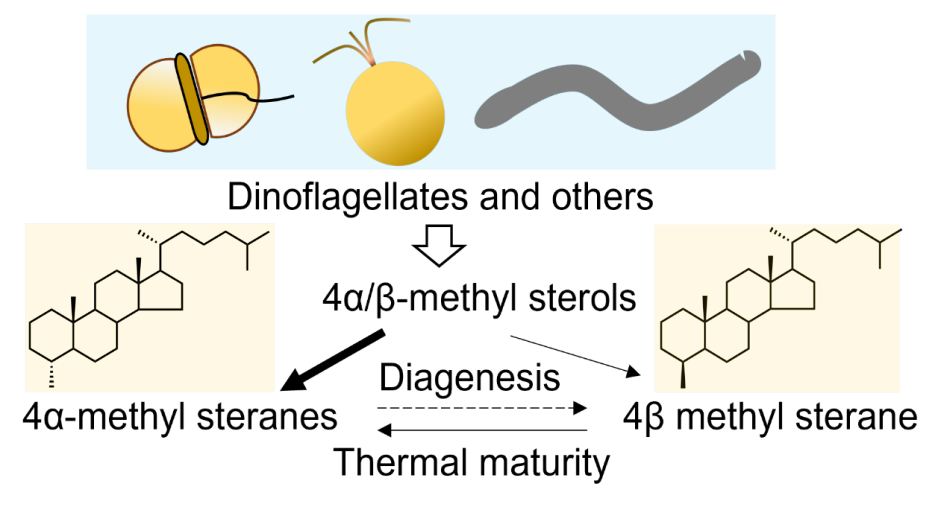原油是国家工业的血液。生物地质学是预测地下油气藏存在的重要手段。岩层中C4-甲基甾烷丰度的变化被广泛用于生物演化和地质变迁史研究。其异构体形式C4α-甲基甾烷的生物来源已得到业界肯定性共识,但其生物合成路径始终未得到实验证实。而其异构体形式C4β-甲基甾烷的来源则一直存在争议;自然界中几乎没有发现它的生物来源。长期以来,C4β-甲基甾烷被认为是C4α-甲基甾醇在成岩过程中形成,C4α-与C4β-甲基甾烷的比例则被作为沉积物成熟度的重要指标,用于原油和天然气的勘探。简单讲,越是古老的岩层,其C4α/β比值越高,岩层成熟度越高,越可能形成原油。因此,C4-甲基甾醇的生物合成机制的阐释具有重要的理论意义和现实价值。
虫黄藻是化石证据最丰富的物种之一。其与宿主珊瑚之间的共生关系可以追溯到中奥陶纪(The Middle Ordovician)到二叠纪晚期(The Late Permian;450 – 251 Ma)。虫黄藻为生物演化和地质学研究在时间和空间尺度上提供了大量的、持续性的化石证据。近日,我校海洋学院、南海海洋资源利用国家重点实验室路延笃团队在珊瑚共生虫黄藻中发现了一种新型的、可共合成C4α-与C4β-甲基甾醇的生物合成机制。并证明该机制广泛存在于囊泡虫类(alveolates,如虫黄藻)和鞭毛藻类(haptophytes,如金藻)等全球性分布的浮游生物中;而这些生物在海洋生物地球化学过程中发挥着重要的影响。这一发现修正了C4α-与C4β-甲基甾烷来源的经典模型,将进一步完善沉积物成熟度指标的测算方法,为解释地质变迁史和原油勘探提供了新的理论支撑。该工作于5月13日在线发表于Journal of the American Chemical Society。
该研究获得了国家重点研发计划(2021YFA0909600、2021YFE0110100)、国家自然科学基金(32060061、3120006)、海南省重点研发计划(ZDYF2022XDNY140)、南海海洋资源利用国家重点实验室开放课题(MRUKF2021003)等的支持。国家重点实验室周文序副教授作为第一作者,路延笃教授作为通信作者,2019级硕士生张旭、2020级硕士生王傲琪、杨琳等参与了本工作。海南大学为第一单位,联合美国麻省理工大学地球大气与行星学院、澳大利亚联邦科学与工业研究组织海洋大气研究所、同济大学海洋地质国家重点实验室完成,并得到同济大学海洋与地球科学学院易亮副院长等的支持。
文章链接:https://pubs.acs.org/doi/10.1021/jacs.2c01401

海南大学是国家“211工程”重点建设大学,教育部与海南省政府“部省合建高校”,是国家“世界一流学科建设高校”。2018年,海南省政府工作报告明确提出“聚全省之力办好海南大学”:海南大学入选“部省合建”高校,纳入教育部直属高校排序。随着国家自由贸易港、国家生态学文明试验区(海南)等重大工程的推进,海南大学又迎来新的历史机遇。南海海洋资源利用国家重点实验室是于2016年8月通过科技部批准成立的海南省首个国家重点实验室,是海洋领域八个国家重点实验室之一(截止到2020年)。中国工程院院士张偲与中国科学院院士戴民汉担任首届学术委员会委员。实验室依托省内唯一的国家一流学科建设高校海南大学建设,服务于我国海洋强国战略和海南地方经济发展。
海洋单细胞生物工程团队致力于(1)单细胞生物代谢路径解析与调控;(2)以微藻为底盘的合成生物学技术开发;(3)单细胞生物与环境互作机制及修复技术。近年承担国家重点研发计划专项课题、国家重点研发计划国际合作重点项目、国家十三五海洋经济创新发展重点项目、国家自然科学基金委、国家知识产权局运营服务体系建设专项、中国博士后基金等项目。成果收录于Nature Comm、Advanced Science等。因课题需要,团队竭诚招聘讲师、国内外优秀博士后研究人员。
详情请访问:http://www.scbioengineering.com/recruit
Call for Postdoctoral and Doctoral Programs for International Students
(No time limits)
Hainan Province locates on the southernmost tip of China and is the only Free Trade Island of China. Hainan University (HNU) is a comprehensive key university jointly administered by the State Ministry of Education and the People’s Government of Hainan Province. It is a leading university for science research and teaching of Hainan Province and was listed as one of China’s “211 Project” universities, one of the 14 universities in the “Midwest Universities Comprehensive Strength Promotion Project”, and a national-level key sponsored university in the “One Province, One School” project in the Midwest of China. In 2017, HNU was selected as the national “Double First-Class” Initiative to develop world-class disciplines. As an integrated institute of Hainan University, HNU has become one of the research and education centers in China.
Unicellular planktons, with an estimate of almost one million species, are of great ecological importance, as they contribute almost half of the global organic carbon fixation. They provide a variety of natural products to support ecosystems (e.g., coral reef ecosystem) by photosynthesis with efficiencies approximately three times greater than those achieved by land plants. Domesticated microalgae hold great promise for the sustainable provision of various bioresources for human domestic and industrial consumption.
The main interest of Single-cell BioEngineering Group (SCBE) is the evolution, function, and editing of single-cell microalgal genomes and design of synthetic biology using microalgae as chassis, including (1) Characterization and engineering crucial biological process and value-added chemical in microalgae (Zhou et al., 2022 JACS; Lu et al., 2021 Nat Comm); (2) Development and application of synthetic biology in cell factory design for medical, industrial, and agriculture ends (Lu et al., 2021 Cri Rev Biotech); (3) The interaction mechanism between microalgae and other microbes and strategy development for heavy-metal remediation approach using these consortia (Ahamad et al., J Harz Mater 2019, 2018).
We are now calling for Postdoctoral and Doctoral Programs for International Students